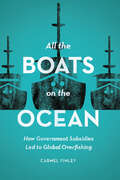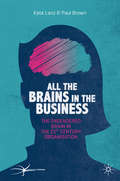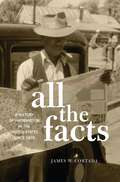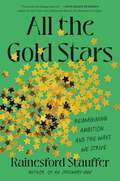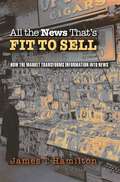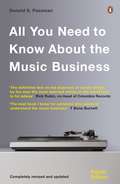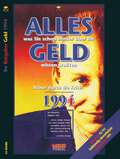- Table View
- List View
All the Boats on the Ocean: How Government Subsidies Led to Global Overfishing
by Carmel FinleyMost current fishing practices are neither economically nor biologically sustainable. Every year, the world spends $80 billion buying fish that cost $105 billion to catch, even as heavy fishing places growing pressure on stocks that are already struggling with warmer, more acidic oceans. How have we developed an industry that is so wasteful, and why has it been so difficult to alter the trajectory toward species extinction? In this transnational, interdisciplinary history, Carmel Finley answers these questions and more as she explores how government subsidies propelled the expansion of fishing from a coastal, in-shore activity into a global industry. While nation states struggling for ocean supremacy have long used fishing as an imperial strategy, the Cold War brought a new emphasis: fishing became a means for nations to make distinct territorial claims. A network of trade policies and tariffs allowed cod from Iceland and tuna canned in Japan into the American market, destabilizing fisheries in New England and Southern California. With the subsequent establishment of tuna canneries in American Samoa and Puerto Rico, Japanese and American tuna boats moved from the Pacific into the Atlantic and Indian Oceans after bluefin. At the same time, government subsidies in nations such as Spain and the Soviet Union fueled fishery expansion on an industrial scale, with the Soviet fleet utterly depleting the stock of rosefish (or Pacific ocean perch) and other groundfish from British Columbia to California. This massive global explosion in fishing power led nations to expand their territorial limits in the 1970s, forever changing the seas. Looking across politics, economics, and biology, All the Boats on the Ocean casts a wide net to reveal how the subsidy-driven expansion of fisheries in the Pacific during the Cold War led to the growth of fisheries science and the creation of international fisheries management. Nevertheless, the seas are far from calm: in a world where this technologically advanced industry has enabled nations to colonize the oceans, fish literally have no place left to hide, and the future of the seas and their fish stocks is uncertain.
All the Boats on the Ocean: How Government Subsidies Led to Global Overfishing
by Carmel FinleyMost current fishing practices are neither economically nor biologically sustainable. Every year, the world spends $80 billion buying fish that cost $105 billion to catch, even as heavy fishing places growing pressure on stocks that are already struggling with warmer, more acidic oceans. How have we developed an industry that is so wasteful, and why has it been so difficult to alter the trajectory toward species extinction? In this transnational, interdisciplinary history, Carmel Finley answers these questions and more as she explores how government subsidies propelled the expansion of fishing from a coastal, in-shore activity into a global industry. While nation states struggling for ocean supremacy have long used fishing as an imperial strategy, the Cold War brought a new emphasis: fishing became a means for nations to make distinct territorial claims. A network of trade policies and tariffs allowed cod from Iceland and tuna canned in Japan into the American market, destabilizing fisheries in New England and Southern California. With the subsequent establishment of tuna canneries in American Samoa and Puerto Rico, Japanese and American tuna boats moved from the Pacific into the Atlantic and Indian Oceans after bluefin. At the same time, government subsidies in nations such as Spain and the Soviet Union fueled fishery expansion on an industrial scale, with the Soviet fleet utterly depleting the stock of rosefish (or Pacific ocean perch) and other groundfish from British Columbia to California. This massive global explosion in fishing power led nations to expand their territorial limits in the 1970s, forever changing the seas. Looking across politics, economics, and biology, All the Boats on the Ocean casts a wide net to reveal how the subsidy-driven expansion of fisheries in the Pacific during the Cold War led to the growth of fisheries science and the creation of international fisheries management. Nevertheless, the seas are far from calm: in a world where this technologically advanced industry has enabled nations to colonize the oceans, fish literally have no place left to hide, and the future of the seas and their fish stocks is uncertain.
All the Boats on the Ocean: How Government Subsidies Led to Global Overfishing
by Carmel FinleyMost current fishing practices are neither economically nor biologically sustainable. Every year, the world spends $80 billion buying fish that cost $105 billion to catch, even as heavy fishing places growing pressure on stocks that are already struggling with warmer, more acidic oceans. How have we developed an industry that is so wasteful, and why has it been so difficult to alter the trajectory toward species extinction? In this transnational, interdisciplinary history, Carmel Finley answers these questions and more as she explores how government subsidies propelled the expansion of fishing from a coastal, in-shore activity into a global industry. While nation states struggling for ocean supremacy have long used fishing as an imperial strategy, the Cold War brought a new emphasis: fishing became a means for nations to make distinct territorial claims. A network of trade policies and tariffs allowed cod from Iceland and tuna canned in Japan into the American market, destabilizing fisheries in New England and Southern California. With the subsequent establishment of tuna canneries in American Samoa and Puerto Rico, Japanese and American tuna boats moved from the Pacific into the Atlantic and Indian Oceans after bluefin. At the same time, government subsidies in nations such as Spain and the Soviet Union fueled fishery expansion on an industrial scale, with the Soviet fleet utterly depleting the stock of rosefish (or Pacific ocean perch) and other groundfish from British Columbia to California. This massive global explosion in fishing power led nations to expand their territorial limits in the 1970s, forever changing the seas. Looking across politics, economics, and biology, All the Boats on the Ocean casts a wide net to reveal how the subsidy-driven expansion of fisheries in the Pacific during the Cold War led to the growth of fisheries science and the creation of international fisheries management. Nevertheless, the seas are far from calm: in a world where this technologically advanced industry has enabled nations to colonize the oceans, fish literally have no place left to hide, and the future of the seas and their fish stocks is uncertain.
All the Brains in the Business: The Engendered Brain in the 21st Century Organisation (The Neuroscience of Business)
by Kate Lanz Paul BrownThe power of gender difference, not gender equality, is a secret source for success. Some smart businesses are starting to wake up to this fact. This book explores why and how. Properly valuing brain gender diversity in the workplace is one of the biggest and largely untapped sources of competitive advantage for modern businesses. Recent advances in neuroscience provide the key to unlocking it. Modern research shows that there are gender-based differences in the brain – it’s just not as simple as a binary between a ‘male brain’ and ‘female brain’. In fact, our brains are like a mosaic where many of the tiles are available in thousands of shades on a spectrum between pink and blue. The problem is that our workplaces tend to be governed by structures, processes and cultures that are practically pure blue. All the brains in the business that are elsewhere on the spectrum cannot thrive as they might, so sources of productivity, creativity and agility go untapped. Anyone who manages people needs to understand how the brain works and the impact it has on how people work together as teams. Anyone who wants to unlock the talent and productivity of all of their people needs to understand how recent findings around male- and female-type brains should shape the way they manage. Leading applied neuroscientists and international corporate coaches Kate Lanz and Paul Brown show you why and how to access all the brains in your business.
All the Facts: A History of Information in the United States since 1870
by James W. CortadaAll the Facts presents a history of the role of information in the United States since 1870, when the nation began a nearly 150-year period of economic prosperity and technological and scientific transformations. James Cortada argues that citizens and their institutions used information extensively as tools to augment their work and private lives and that they used facts to help shape how the nation evolved during these fourteen decades. He argues that information's role has long been a critical component of the work, play, culture, and values of this nation, and no more so than during the twentieth century when its function in society expanded dramatically. While elements of this story have been examined by thousands of scholars---such as the role of radio, newspapers, books, computers, and the Internet, about such institutions as education, big business, expanded roles of governments from town administration to the state house, from agriculture to the services and information industries---All the Facts looks at all of these elements holistically, providing a deeper insight into the way the United States evolved over time. An introduction and 11 chapters describe what this information ecosystem looked like, how it evolved, and how it was used. For another vast layer of information about this subject the reader is directed to the detailed bibliographic essay in the back of this book. It includes a narrative history, case studies in the form of sidebars, and stories illustrating key points. Readers will find, for example, the story of how the US postal system helped create today's information society, along with everything from books and newspapers to TV, computers, and the Internet. The build-up to what many today call the Information Age took a long time to achieve and continues to build momentum. The implications for the world, and not just for the United States, are as profound as any mega-trend one could identify in the history of humankind. All the Facts presents this development thoroughly in an easy-to-digest format that any lover of history, technology, or the history of information and business will enjoy.
All the Facts: A History of Information in the United States since 1870
by James W. CortadaAll the Facts presents a history of the role of information in the United States since 1870, when the nation began a nearly 150-year period of economic prosperity and technological and scientific transformations. James Cortada argues that citizens and their institutions used information extensively as tools to augment their work and private lives and that they used facts to help shape how the nation evolved during these fourteen decades. He argues that information's role has long been a critical component of the work, play, culture, and values of this nation, and no more so than during the twentieth century when its function in society expanded dramatically. While elements of this story have been examined by thousands of scholars---such as the role of radio, newspapers, books, computers, and the Internet, about such institutions as education, big business, expanded roles of governments from town administration to the state house, from agriculture to the services and information industries---All the Facts looks at all of these elements holistically, providing a deeper insight into the way the United States evolved over time. An introduction and 11 chapters describe what this information ecosystem looked like, how it evolved, and how it was used. For another vast layer of information about this subject the reader is directed to the detailed bibliographic essay in the back of this book. It includes a narrative history, case studies in the form of sidebars, and stories illustrating key points. Readers will find, for example, the story of how the US postal system helped create today's information society, along with everything from books and newspapers to TV, computers, and the Internet. The build-up to what many today call the Information Age took a long time to achieve and continues to build momentum. The implications for the world, and not just for the United States, are as profound as any mega-trend one could identify in the history of humankind. All the Facts presents this development thoroughly in an easy-to-digest format that any lover of history, technology, or the history of information and business will enjoy.
All the Gold Stars: Reimagining Ambition and the Ways We Strive
by Rainesford StaufferFrom journalist and author of An Ordinary Age, an examination, dismantling, and reconstruction of ambition, where burnout is the symptom of our holiest sin: the lonely way we strive. Ambition—the want, the hunger, the need to achieve—is woven into America&’s fabric from the first colonization to capitalism. From our first gold star assignment to acceptance at the &“right&” college to hustle and grinding our lives, we celebrate our drive, even as we gatekeep who is permitted to strive--and how visibly. Even as we burn out. When we can&’t even. When we know: work won&’t love us back.All the Gold Stars looks at how the cultural, personal, and societal expectations around ambition are driving the burnout epidemic by funneling our worth into productivity, limiting our imaginations, and pushing us further apart. Through the devastating personal narrative of her own ambition crisis, Stauffer discovers the common factors driving us all, peeling back layers of family expectations, capitalism, and self-esteem that dangerously tie up our worth in our output. Interviews with students, parents, workers, psychologists, labor organizers, and more offer a new definition of ambition and the tools to reframe our lives around true success. All the Gold Stars provides ways for us to reject our current reality and reconceive ambition as more collective, imaginative, and rooted in caring for ourselves and each other.
All the Math You'll Ever Need: A Self-Teaching Guide (Wiley Self-Teaching Guides)
by Carolyn C. Wheater Steve SlavinA comprehensive and hands-on guide to crucial math concepts and terminology In the newly revised third edition of All the Math You’ll Ever Need: A Self-Teaching Guide, veteran math and computer technology teacher Carolyn Wheater and veteran mathematics author Steve Slavin deliver a practical and accessible guide to math you can use every day and apply to a wide variety of life tasks. From calculating monthly mortgage payments to the time you’ll need to pay off a credit card, this book walks you through the steps to understanding basic math concepts. This latest edition is updated to reflect recent changes in interest rates, prices, and wages, and incorporates information on the intelligent and efficient use of calculators and mental math techniques. It also offers: A brand-new chapter on hands-on statistics to help readers understand common graphs An easy-to-use-format that provides an interactive method with frequent questions, problems, and self-tests Complete explanations of necessary mathematical concepts that explore not just how math works, but also why it worksPerfect for anyone seeking to make practical use of essential math concepts and strategies in their day-to-day life, All the Math You’ll Ever Need is an invaluable addition to the libraries of students who want a bit of extra help applying math in the real world.
All the Math You'll Ever Need: A Self-Teaching Guide (Wiley Self-Teaching Guides #148)
by Carolyn C. Wheater Steve SlavinA comprehensive and hands-on guide to crucial math concepts and terminology In the newly revised third edition of All the Math You’ll Ever Need: A Self-Teaching Guide, veteran math and computer technology teacher Carolyn Wheater and veteran mathematics author Steve Slavin deliver a practical and accessible guide to math you can use every day and apply to a wide variety of life tasks. From calculating monthly mortgage payments to the time you’ll need to pay off a credit card, this book walks you through the steps to understanding basic math concepts. This latest edition is updated to reflect recent changes in interest rates, prices, and wages, and incorporates information on the intelligent and efficient use of calculators and mental math techniques. It also offers: A brand-new chapter on hands-on statistics to help readers understand common graphs An easy-to-use-format that provides an interactive method with frequent questions, problems, and self-tests Complete explanations of necessary mathematical concepts that explore not just how math works, but also why it worksPerfect for anyone seeking to make practical use of essential math concepts and strategies in their day-to-day life, All the Math You’ll Ever Need is an invaluable addition to the libraries of students who want a bit of extra help applying math in the real world.
All the Money in the World: previously published as Painfully Rich
by John PearsonInspired by the most infamous incident involving the Getty family - now a major film directed by Ridley Scott, starring Mark Wahlberg, Michelle Williams and Oscar® Nominee Christopher PlummerOil tycoon J. Paul Getty created the greatest fortune in America - and came close to destroying his own family in the process. Of his four sons who reached manhood, only one survived relatively unscathed. One killed himself, one became a drug-addicted recluse and the third had to bear the stigma all his life of being disinherited in childhood.The unhappiness continued into the next generation, with the name Getty, as one journalist put it, 'becoming synonymous for family dysfunction'. Getty's once favourite grandson John Paul Getty III was kidnapped by the Italian mafia who cut off his ear to raise a ransom and, after a lifetime of drink and drugs, became a paraplegic. His granddaughter Aileen has AIDS. And the Getty family itself has been torn apart by litigation over their poisoned inheritance.But did the disaster have to happen? John Pearson, who has specialized in biographies of families as varied as the Churchills, the British Royal Family, the Devonshires and the Krays, sets out to find the answer. The result, first published in 1995, is a fascinating saga of an extraordinary dynasty.He traces much of the trouble to the bizarre character of the avaricious, sex-obsessed billionaire, J. Paul Getty himself - and demonstrates how much of his behaviour has been repeated in succeeding generations. He describes the famous kidnapping of his grandson in graphic detail, revealing how the old man's attitude added considerably to the boy's sufferings. And he shows how the family has coped with the latest modern scourges: drugs and AIDS.For All the Money in the World is not a hopeless story. While some of the family have been damaged by the Getty legacy, others have saved themselves from disaster, most notably the cricket-loving philanthropist, J. Paul Getty Jr. Pearson's moving story of his recovery from drugs and deep personal tragedy shows that there is hope for future generations of this stricken family - and demonstrates that money can be used to buy survival and even happiness.
All the News That’s Fit to Sell: How the Market Transforms Information into News
by James T. HamiltonThat market forces drive the news is not news. Whether a story appears in print, on television, or on the Internet depends on who is interested, its value to advertisers, the costs of assembling the details, and competitors' products. But in All the News That's Fit to Sell, economist James Hamilton shows just how this happens. Furthermore, many complaints about journalism--media bias, soft news, and pundits as celebrities--arise from the impact of this economic logic on news judgments. This is the first book to develop an economic theory of news, analyze evidence across a wide range of media markets on how incentives affect news content, and offer policy conclusions. Media bias, for instance, was long a staple of the news. Hamilton's analysis of newspapers from 1870 to 1900 reveals how nonpartisan reporting became the norm. A hundred years later, some partisan elements reemerged as, for example, evening news broadcasts tried to retain young female viewers with stories aimed at their (Democratic) political interests. Examination of story selection on the network evening news programs from 1969 to 1998 shows how cable competition, deregulation, and ownership changes encouraged a shift from hard news about politics toward more soft news about entertainers. Hamilton concludes by calling for lower costs of access to government information, a greater role for nonprofits in funding journalism, the development of norms that stress hard news reporting, and the defining of digital and Internet property rights to encourage the flow of news. Ultimately, this book shows that by more fully understanding the economics behind the news, we will be better positioned to ensure that the news serves the public good.
All the News That’s Fit to Sell: How the Market Transforms Information into News (PDF)
by James T. HamiltonThat market forces drive the news is not news. Whether a story appears in print, on television, or on the Internet depends on who is interested, its value to advertisers, the costs of assembling the details, and competitors' products. But in All the News That's Fit to Sell, economist James Hamilton shows just how this happens. Furthermore, many complaints about journalism--media bias, soft news, and pundits as celebrities--arise from the impact of this economic logic on news judgments. This is the first book to develop an economic theory of news, analyze evidence across a wide range of media markets on how incentives affect news content, and offer policy conclusions. Media bias, for instance, was long a staple of the news. Hamilton's analysis of newspapers from 1870 to 1900 reveals how nonpartisan reporting became the norm. A hundred years later, some partisan elements reemerged as, for example, evening news broadcasts tried to retain young female viewers with stories aimed at their (Democratic) political interests. Examination of story selection on the network evening news programs from 1969 to 1998 shows how cable competition, deregulation, and ownership changes encouraged a shift from hard news about politics toward more soft news about entertainers. Hamilton concludes by calling for lower costs of access to government information, a greater role for nonprofits in funding journalism, the development of norms that stress hard news reporting, and the defining of digital and Internet property rights to encourage the flow of news. Ultimately, this book shows that by more fully understanding the economics behind the news, we will be better positioned to ensure that the news serves the public good.
All the Presidents' Bankers: The Hidden Alliances that Drive American Power
by Nomi PrinsA groundbreaking narrative of how an elite group of men transformed the American economy and government, dictated foreign and domestic policy, and shaped world history.Culled from original presidential archival documents, All the Presidents' Bankers delivers an explosive account of the hundred-year interdependence between the White House and Wall Street that transcends a simple analysis of money driving politics-or greed driving bankers.Nomi Prins ushers us into the intimate world of exclusive clubs, vacation spots, and Ivy League universities that binds presidents and financiers. She unravels the multi-generational blood, intermarriage, and protégé relationships that have confined national influence to a privileged cluster of people. These families and individuals recycle their power through elected office and private channels in Washington, DC.From the Panic of 1907 to the financial crisis of 2008, this unprecedented history of American power illuminates how the same financiers retained their authoritative position through history, swaying presidents regardless of party affiliation. All the Presidents' Bankers explores the alarming global repercussions of a system lacking barriers between public office and private power. Prins leaves us with an ominous choice: either we break the alliances of the power elite, or they will break us.
All the Presidents' Bankers: The Hidden Alliances that Drive American Power
by Nomi PrinsA groundbreaking narrative of how an elite group of men transformed the American economy and government, dictated foreign and domestic policy, and shaped world history. Culled from original presidential archival documents, All the Presidents' Bankers delivers an explosive account of the hundred-year interdependence between the White House and Wall Street that transcends a simple analysis of money driving politics-or greed driving bankers. Nomi Prins ushers us into the intimate world of exclusive clubs, vacation spots, and Ivy League universities that binds presidents and financiers. She unravels the multi-generational blood, intermarriage, and proté relationships that have confined national influence to a privileged cluster of people. These families and individuals recycle their power through elected office and private channels in Washington, DC. From the Panic of 1907 to the financial crisis of 2008, this unprecedented history of American power illuminates how the same financiers retained their authoritative position through history, swaying presidents regardless of party affiliation. All the Presidents' Bankers explores the alarming global repercussions of a system lacking barriers between public office and private power. Prins leaves us with an ominous choice: either we break the alliances of the power elite, or they will break us.
All Thumbs: Mobile Marketing that Works
by M. KelleyMobile devices are now in the hands of nearly half of the world's population. However, 80% of mobile marketing either doesn't work and has a high abandon rate, or doesn't fit into a brand's overall strategy. Aimed at businesses of all sizes, this practical guide shows owners and marketers how to develop a campaign that gets results.
All Time Essentials for Entrepreneurs: 100 Things to Know and Do to Make Your Idea Happen
by Jonathan YatesA pocket-sized pep-talk packed with inspiration and motivation. Got an idea for a business? Just started out? Or wondering what to do next? From planning and setting up, to raising finance and making a profit, All-Time Essentials for Entrepreneurs is your one-stop shop for advice and tips on everything you need to know and do to get your business off the ground. Jonathan Yates is a serial entrepreneur who understands that when you're launching or running your own business, you need ideas and answers fast. He runs regular seminars showing people just like you how to achieve their goals. His top 10 tips for success have been compared to those of business mogul and Apprentice TV show chairman, Sir Alan Sugar. Blending indispensable advice and short bursts of inspiration with motivational quotes from the world's greatest thinkers, All-Time Essentials for Entrepreneurs is the smart little sidekick you'll find yourself turning to again and again. 'Jonathan has tremendous energy and drive. You can tap into that energy in this book.' Sahar Hashemi, co-founder of Coffee Republic 'Jonathan is one of those rare individuals who has great business acumen as well as entrepreneurial insight. His passion to succeed is infectious.' Mike Clare, Dreams
All Time Essentials for Entrepreneurs: 100 Things to Know and Do to Make Your Idea Happen
by Jonathan YatesA pocket-sized pep-talk packed with inspiration and motivation. Got an idea for a business? Just started out? Or wondering what to do next? From planning and setting up, to raising finance and making a profit, All-Time Essentials for Entrepreneurs is your one-stop shop for advice and tips on everything you need to know and do to get your business off the ground. Jonathan Yates is a serial entrepreneur who understands that when you're launching or running your own business, you need ideas and answers fast. He runs regular seminars showing people just like you how to achieve their goals. His top 10 tips for success have been compared to those of business mogul and Apprentice TV show chairman, Sir Alan Sugar. Blending indispensable advice and short bursts of inspiration with motivational quotes from the world's greatest thinkers, All-Time Essentials for Entrepreneurs is the smart little sidekick you'll find yourself turning to again and again. 'Jonathan has tremendous energy and drive. You can tap into that energy in this book.' Sahar Hashemi, co-founder of Coffee Republic 'Jonathan is one of those rare individuals who has great business acumen as well as entrepreneurial insight. His passion to succeed is infectious.' Mike Clare, Dreams
All You Can Pay: How Companies Use Our Data to Empty Our Wallets
by Anna Bernasek D.T. MonganWhile millions of consumers carry on unaware, powerful companies are racing to gain more knowledge and data than anyone, including any government, has ever had. The goal is to understand consumer behavior and desires, from mundane matters to our most private and intimate affairs. This massive trove of data represents an immense prize for these companies. In economic terms, it is one of the most valuable assets on the planet.In All You Can Pay, Anna Bernasek and D.T. Mongan show how companies use what they know about you to determine how much you are willing to pay for certain products and services. Colleges calculate the price you pay based on the information revealed in the application almost all parents submit for federal aid. Hotels, sports events and health products and services are also using this strategy. The price of everything online-from airline tickets to toilet paper-now fluctuates from moment to moment. Through a toxic combination of price discrimination and cutting-edge technology, sellers can instantly change the price they charge an individual based on their calculations of demand and supply at that point in time. Online stores use your zip code to charge you a different price from someone in another zip code.Bernasek and Mongan offer a dire warning and demonstrate how big data threatens the very icon of the American way: the free market. The ability to understand consumers on a granular level, in real time, and simultaneously to customize the price each person is offered, shifts the balance of power away from the consumer so dramatically that the freedom of markets is at risk. The trend is alarming and, if left unchecked, the destination is clear. Yet consumers and companies can still choose a different path, and in this chilling and illuminating book, Bernasek and Mongan show us how.
All You Need is a Good Idea!: How to Create Marketing Messages that Actually Get Results
by Jay H. HeymanIn All You Need Is a Good Idea, Jay Heyman shows you how to create powerful marketing and advertising ideas that will dramatically increase sales for your business. Perfect for entrepreneurs and small business owners?or operators of any size business, for that matter?this valuable marketing resource will help any business stand out in the marketplace, build bigger market share, gain publicity, and scare the pants off the competition. This book is the perfect guide to creating truly powerful marketing messages.
All You Need to Know About the Music Business: Eighth Edition
by Donald S PassmanAll You Need To Know About The Music Business - The new edition of 'the industry bible' (Los Angeles Times) by Donald S. PassmanNo one understands the music business and the changes it has undergone in recent years better than LA lawyer Donald Passman. For 20 years his book has offered detailed advice to artists and executives, novices and experts alike on how to thrive in these volatile times.This completely revised edition sets out recent developments in record deals, copyright, new technologies and film music. It also offers unique advice on how to navigate your way through the ins and outs of songwriting, music publishing, merchandising and performing. Whether you're a newcomer or an established professional, All You Need to Know about the Music Business is an essential companion. It will also be loved by readers of The Music Business and How Music Works by David Byrne.'The definitive text on the business of music written by the man the most talented artists in the world look to for advice' Ron Rubin, co-head of Columbia Records'Should be required reading for anyone planning or enduring a career in the biz' Rolling StoneDonald Passman is a graduate of the University of Texas and the Harvard Law School. For many years he has practised law with the LA firm of Gang, Tyre, Ramer and Brown, where he specializes in the music and film industries. He represents many famous music clients. He lives in LA with his wife and four children, and plays guitar and five-string banjo.
Alle, nicht jeder: Einführung in die Methoden der Demoskopie
by Elisabeth Noelle-Neumann Thomas PetersenAllein mit der Beobachtungsgabe können wir die soziale Wi- lichkeit nicht wahrnehmen. Wir müssen uns mit Geräten aus- sten, die unsere natürlichen Fähigkeiten verstärken, so wie es für die Beobachtung der Natur längst geschehen ist. Umfragen sind ein solches Hilfsmittel, seit dem Ende des 18. Jahrhunderts mühsam methodisch entwickelt, mit eigen- tigen Verzögerungen, gegen beharrliche Widerstände. »Die empirische Tradition der Erforschung von Meinungen und Einstellungen begann – recht bescheiden – in Deutschland«, schrieb der Pionier der modernen Sozialforschung Paul 1 Lazarsfeld. Aber die Tradition der deutschen Umfragen des 19. und frühen 20. Jahrhunderts war völlig abgerissen und so gut wie vergessen, als nach 1945 Bevölkerungsumfragen in Deutschland wieder aufkamen. Man hielt sie für eine ameri- nische Erfindung. Das neue Beobachtungsinstrument wurde kaum mit Freude begrüßt, nicht als Fortschritt menschlicher Erkenntnismögli- keiten gepriesen. Es weckte Unbehagen. Man wunderte sich, warum plötzlich überall Umfrageergebnisse erschienen, in Z- tungen und im Rundfunk, in den politischen Reden ebenso wie in den Geschäftspapieren der Firmen. Zeitweise dachte man, es sei eine Mode. Heute sind Umfragen aus dem politischen und dem Wi- schaftsleben und aus vielen anderen Bereichen nicht mehr w- zudenken. Doch das Mißtrauen in der Öffentlichkeit ist gebl- ben.
Allein auf stürmischer See: Risikomanagement für Einsteiger
by Roland Erben Frank RomeikeDie spektakulären Firmenzusammenbrüche in den vergangenen Jahren und tief greifende regulatorische Änderungen zwingen die Unternehmen, ein ganzheitlich orientiertes Risikomanagementsystem zu implementieren. Vielen Managern fehlt jedoch das erforderliche Fach-Know-how für eine wirklich fundierte Beurteilung der komplexen Entscheidungsalternativen. Allerdings gelingt es den hoch spezialisierten Risk Managern auch nicht, die Entscheidungsebene für die anstehenden Probleme zu sensibilisieren. Mit dem Thema Risikomanagement will man sich nicht beschäftigen, sondern man muss es tun. Letztlich bleibt die Risikomanagement-Abteilung für viele Entscheidungsträger eine Black Box. Man weiß einfach nicht so recht, was dort vor sich geht. Allein auf stürmischer See schließt diese Kommunikations- und Verständnislücke. Jenseits von abstrakten mathematischen Formeln und realitätsfernen Modellen bieten Roland Franz Erben und Frank Romeike eine verständliche und kurzweilige Auseinandersetzung mit der oft schwer verdaulichen Materie. Fachlich fundiert und dennoch unterhaltsam erklären sie die wesentlichen Fragestellungen des Risikomanagements anhand der Geschichte zweier Schiffskapitäne. Während Henry Salt durch sein mangelhaftes Risikomanagement keine Gefahr auslässt, hat Charly Sugar durch effiziente Frühwarnsysteme und eine gelebte Risikokultur das Steuer seines Schiffes fest in der Hand. Der Leser begleitet die beiden Seebären auf Ihrer Reise über die sieben Weltmeere und erfährt mehr über Fragen wie z. B.: Was ist Risiko eigentlich? Welche Ziele verfolgt das Risikomanagement? Wie bekomme ich meine Risiken optimal in den Griff? Wie kann ein gutes Risikomanagement den Wert meines Unternehmens steigern? Die Neuauflage wird grundlegend überarbeitet und aktualisiert. Zum Beispiel werden neuere Entwicklungen, Studien und methodische Ansätze im Risikomanagement berücksichtigt. Zum Beispiel wird dem Thema "kognitive Verzerrungen im Risikomanagement" ein zusätzliches Kapitel gewidmet.
